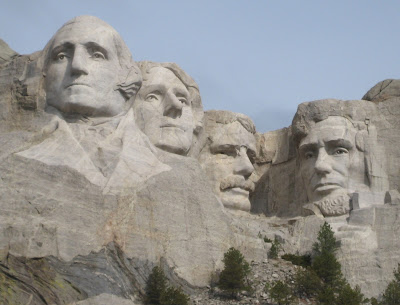We decided to take one of the recommended driving tours through the Black Hills. After driving through the small town of Keystone, our first stop was Mount Rushmore, where the granite portraits of George Washington, Thomas Jefferson, Theodore Roosevelt and Abraham Lincoln overlook the Black Hills. In 1927, sculptor Gutzon Borglum began carving this memorial dedicated to the history of America with the help of over 400 workers. Work was done on an "on and off method" due to the lack of funding. Work also was stopped during World War II. Borglum died in March 1941 and his son, Lincoln, supervised the completion of the heads. These huge granite carvings represent the American ideals for which our country was founded back in 1776.
The carving of George Washington's head is as tall as a six-story building. The one-dollar bill may someday be obsolete but this carving will live on for future generations to enjoy.
There was significant debate to carve Abe Lincoln "with" or "without" a beard. The beard won out.
Here are some views of the Black Hills with a side view of Mt. Rushmore and George Washington. It is easy to see why these mountains are called the Black Hills. Not being geologists, we do not know why the carvings are almost pure white while the mountain rock is nearly black in color. The carvings on Mount Rushmore is something every American should see in person at least once in his or her lifetime. We think it rivals the Statue of Liberty in New York Harbor and the Freedom Trail in Boston as a "must see."
As we were leaving Mt. Rushmore, we found our first wildlife, a hungry mountain goat eating some grass by the entrance to the Mt. Rushmore parking area. This lone mountain goat was almost the size of a small pony, whiter in color than the picture shows, and seemed out of place between the lanes in and out of the parking garage.
Next stop was the Crazy Horse Memorial. The sculptor who began the project was Korczak Ziolkowski, who was chosen by the Lakota Indian Chief, Henry Standing Bear, in 1947. Since he passed away in 1982, his wife Ruth has directed the continuation of his work on this monument to the American Indian. This photo is of the 16-ton large scale model of what the carving on the mountain will eventually look like. The model is 1/34th scale of the actual carving. Another reference point would be Paul's height of 6 ft. 1 inch.
The mountain carving is in progress, with the 22-story high horse's head now one-half blocked out. On this photo of the actual memorial, you can see some white markings which are the area around the eyes of the horse. The huge hole is the beginnings of the area below Crazy Horse's arm.
The grounds of the Crazy Horse Memorial also contain the Indian Museum of North America. There were many interesting Indian artifacts including arrow heads, tools, articles of clothing, and beaded articles. Possibly the most fascinating area was a large corner of the museum containing several hundred jars of different colored and different shaped glass beads used by the Indians to decorate their clothes, headdresses, and shoes..
Just outside the replica of the sculptor's log studio home, was a trophy case of various memorabilia sent to Ruth in support of the project in honor of the American Indian. Included in this collection is a signed football from Bobby Bowden, with the inscription on the ball written "To Ruth."








Very cool! I am excited to see that you are enjoying the northern route to Wyoming this summer. Mount Rushmore looks more picturesque in your photos than I would have imagined. Given that you are now farther along on your journey, I am optimistic that the RV issues were minor and quickly fixed.
ReplyDelete